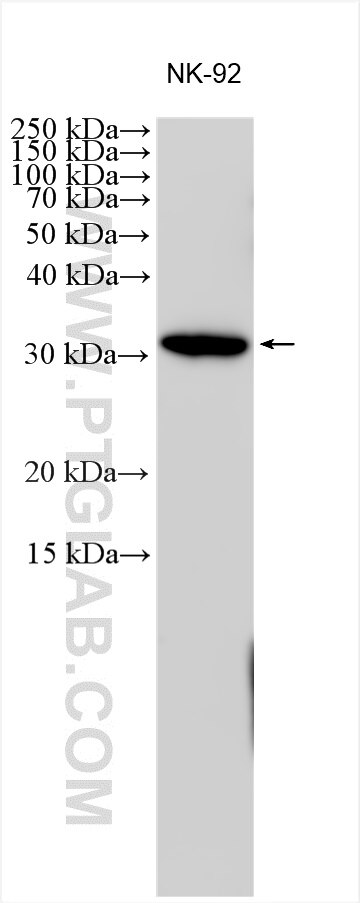Granzyme H Polyklonaler Antikörper
Granzyme H Polyklonal Antikörper für WB, ELISA
Wirt / Isotyp
Kaninchen / IgG
Getestete Reaktivität
human
Anwendung
WB, ELISA
Konjugation
Unkonjugiert
Kat-Nr. : 17228-1-AP
Synonyme
Geprüfte Anwendungen
| Erfolgreiche Detektion in WB | NK-92 cells |
Empfohlene Verdünnung
| Anwendung | Verdünnung |
|---|---|
| Western Blot (WB) | WB : 1:500-1:3000 |
| It is recommended that this reagent should be titrated in each testing system to obtain optimal results. | |
| Sample-dependent, check data in validation data gallery | |
Produktinformation
17228-1-AP bindet in WB, ELISA Granzyme H und zeigt Reaktivität mit human
| Getestete Reaktivität | human |
| Wirt / Isotyp | Kaninchen / IgG |
| Klonalität | Polyklonal |
| Typ | Antikörper |
| Immunogen | Granzyme H fusion protein Ag11069 |
| Vollständiger Name | granzyme H (cathepsin G-like 2, protein h-CCPX) |
| Berechnetes Molekulargewicht | 246 aa, 27 kDa |
| Beobachtetes Molekulargewicht | ~30 kDa |
| GenBank-Zugangsnummer | BC027974 |
| Gene symbol | Granzyme H |
| Gene ID (NCBI) | 2999 |
| Konjugation | Unkonjugiert |
| Form | Liquid |
| Reinigungsmethode | Antigen-Affinitätsreinigung |
| Lagerungspuffer | PBS with 0.02% sodium azide and 50% glycerol |
| Lagerungsbedingungen | Bei -20°C lagern. Nach dem Versand ein Jahr lang stabil Aliquotieren ist bei -20oC Lagerung nicht notwendig. 20ul Größen enthalten 0,1% BSA. |
Hintergrundinformationen
Granzyme H (GzmH) belongs to a family of 5 human serine proteases that are expressed by cytotoxic immune effector cells. It's regarded as an orphan granzyme with unknown biologic functions in immune defense cells. It's reported that this serine protease is predominantly expressed at high levels in natural killer (NK) cells and has chymotrypsin-like (chymase) activity. The calculated molecular weight is 27 kDa, 17228-1-AP can detect a band around 30 kDa. (PMID: 17409270)
Protokolle
| PRODUKTSPEZIFISCHE PROTOKOLLE | |
|---|---|
| WB protocol for Granzyme H antibody 17228-1-AP | Protokoll herunterladen |
| STANDARD-PROTOKOLLE | |
|---|---|
| Klicken Sie hier, um unsere Standardprotokolle anzuzeigen |


